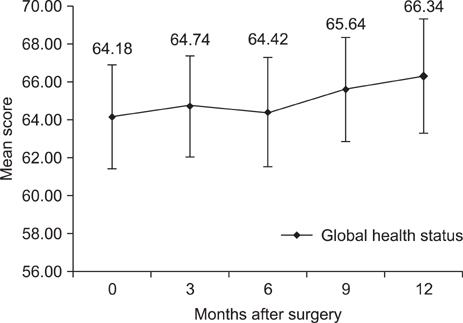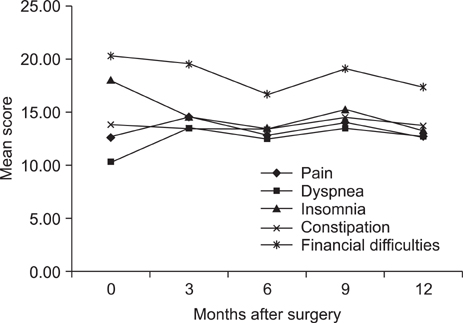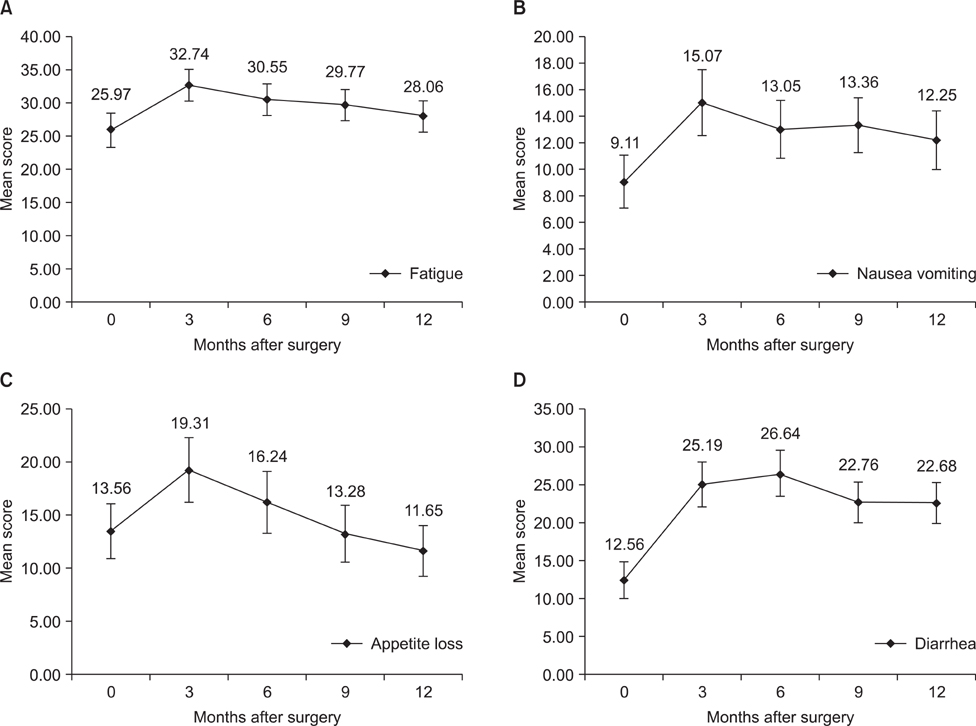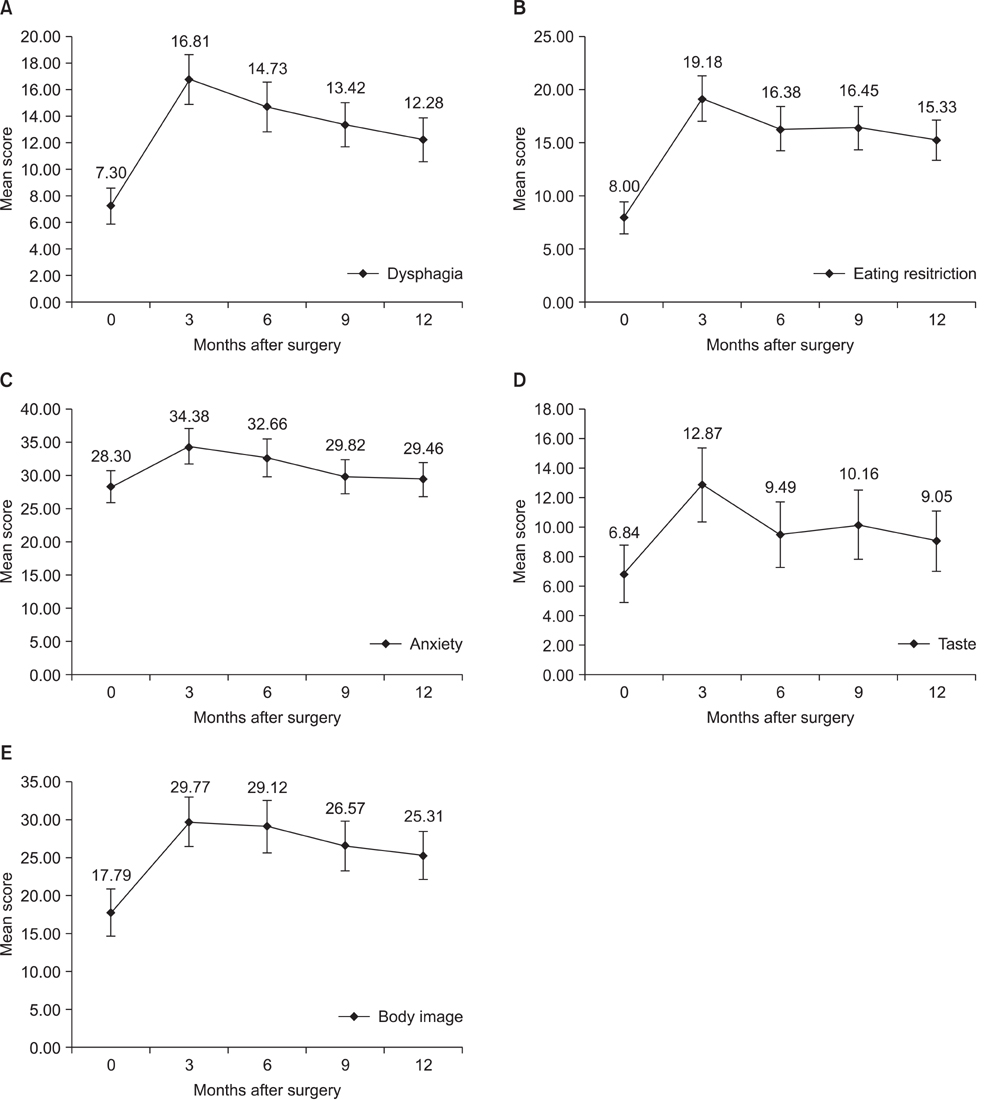J Gastric Cancer.
2012 Sep;12(3):194-200.
Changes of Quality of Life after Gastric Cancer Surgery
- Affiliations
-
- 1Department of Surgery, Kyungpook National University Hospital, Daegu, Korea.
- 2Gastric Cancer Center, Kyungpook National University Medical Center, Daegu, Korea. wyu@knu.ac.kr
Abstract
- PURPOSE
The aim of this study was to evaluate chronological change of quality of life after surgery in patients with gastric cancer during one year postoperatively.
MATERIALS AND METHODS
Quality of life data were obtained from 272 gastric cancer patients who underwent curative gastrectomy between September 2008 and February 2011 at the Kyungpook National University Hospital. The Korean versions of the European Organization for Research and Treatment of Cancer (EORTC) Quality of Life Questionnaire Core (QLQ) 30 with gastric cancer-specific module, the EORTC QLQ-STO22 were used to assess quality of life. All patients had no evidence of recurrence or metastasis during the first postoperative year. Patients were asked to complete the questionnaire, by themselves preoperatively, 3-, 6-, 9-, and 12-months postoperatively.
RESULTS
Physical functioning score and role functioning score significantly decreased at first 3 months after surgery and the significant differences were noticed until 12 months after surgery. Emotional functioning score started with the lowest score before surgery and significant improvement was shown 6 months after surgery. Most symptom scores and STO-22 scores were highest at 3 months after surgery and gradually decreased, thereafter. Eating restriction, anxiety, taste, body image scores was highest at 3 months after surgery without significant decrease afterwards.
CONCLUSIONS
Most scales worsened after surgery and gradually recovered afterwards with some differences in rate of recovery. However the scales did not fully recover by 1 year period. Further follow-up after 1 year would be helpful in determining which scales are permanently damaged and which are just taking longer time to recover.
Keyword
MeSH Terms
Figure
Reference
-
1. Kobayashi D, Kodera Y, Fujiwara M, Koike M, Nakayama G, Nakao A. Assessment of quality of life after gastrectomy using EORTC QLQ-C30 and STO22. World J Surg. 2011. 35:357–364.
Article2. Yu W, Lee CH, Chung HY. Quality of life after curative surgery in patients with gastric cancer: comparison between a subtotal gastrectomy and a total gastrectomy. J Korean Gastric Cancer Assoc. 2001. 1:44–49.
Article3. Yu W, Chung HY. Quality of life and nutritional outcomes of billroth I and billroth II reconstruction. J Korean Gastric Cancer Assoc. 2002. 2:91–95.
Article4. Yasuda K, Shiraishi N, Etoh T, Shiromizu A, Inomata M, Kitano S. Long-term quality of life after laparoscopy-assisted distal gastrectomy for gastric cancer. Surg Endosc. 2007. 21:2150–2153.
Article5. Adachi Y, Suematsu T, Shiraishi N, Katsuta T, Morimoto A, Kitano S, et al. Quality of life after laparoscopy-assisted Billroth I gastrectomy. Ann Surg. 1999. 229:49–54.
Article6. Davies J, Johnston D, Sue-Ling H, Young S, May J, Griffith J, et al. Total or subtotal gastrectomy for gastric carcinoma? A study of quality of life. World J Surg. 1998. 22:1048–1055.
Article7. Takiguchi S, Yamamoto K, Hirao M, Imamura H, Fujita J, Yano M, et al. Osaka University Clinical Research Group for Gastroenterological Study. A comparison of postoperative quality of life and dysfunction after Billroth I and Roux-en-Y reconstruction following distal gastrectomy for gastric cancer: results from a multi-institutional RCT. Gastric Cancer. 2012. 15:198–205.
Article8. Kaptein AA, Morita S, Sakamoto J. Quality of life in gastric cancer. World J Gastroenterol. 2005. 11:3189–3196.
Article9. Svedlund J, Sullivan M, Liedman B, Lundell L, Sjödin I. Quality of life after gastrectomy for gastric carcinoma: controlled study of reconstructive procedures. World J Surg. 1997. 21:422–433.
Article10. Kim YW, Baik YH, Yun YH, Nam BH, Kim DH, Choi IJ, et al. Improved quality of life outcomes after laparoscopy-assisted distal gastrectomy for early gastric cancer: results of a prospective randomized clinical trial. Ann Surg. 2008. 248:721–727.
Article11. Lee SS, Ryu SW, Kim IH, Sohn SS. Quality of life beyond the early postoperative period after laparoscopy-assisted distal gastrectomy: the level of patient expectation as the essence of quality of life. Gastric Cancer. 2012. 15:299–304.
Article12. Munene G, Francis W, Garland SN, Pelletier G, Mack LA, Bathe OF. The quality of life trajectory of resected gastric cancer. J Surg Oncol. 2012. 105:337–341.
Article13. Aaronson NK, Ahmedzai S, Bergman B, Bullinger M, Cull A, Duez NJ, et al. The European Organization for Research and Treatment of Cancer QLQ-C30: a quality-of-life instrument for use in international clinical trials in oncology. J Natl Cancer Inst. 1993. 85:365–376.
Article14. Vickery CW, Blazeby JM, Conroy T, Arraras J, Sezer O, Koller M, et al. EORTC Quality of Life Group. Development of an EORTC disease-specific quality of life module for use in patients with gastric cancer. Eur J Cancer. 2001. 37:966–971.
Article15. Blazeby JM, Conroy T, Bottomley A, Vickery C, Arraras J, Sezer O, et al. European Organisation for Research and Treatment of Cancer Gastrointestinal and Quality of Life Groups. Clinical and psychometric validation of a questionnaire module, the EORTC QLQ-STO 22, to assess quality of life in patients with gastric cancer. Eur J Cancer. 2004. 40:2260–2268.
Article16. Wu CW, Chiou JM, Ko FS, Lo SS, Chen JH, Lui WY, et al. Quality of life after curative gastrectomy for gastric cancer in a randomised controlled trial. Br J Cancer. 2008. 98:54–59.
Article17. Schmidt-Matthiesen A, Weidmann R, Sänger P. Longitudinal study on quality of life after gastrectomy for gastric cancer and starting points for intensified care. Zentralbl Chir. 2003. 128:304–308.
Article
- Full Text Links
- Actions
-
Cited
- CITED
-
- Close
- Share
- Similar articles
-
- A Study of the Quality of Life Following after Curative Surgery for Gastric Cancer
- Preoperative Quality of Life in Patients with Gastric Cancer
- Conventional Open Surgery in Early Gastric Cancer
- Quality of life after total gastrectomy in the gastric cancer patients
- Quality of Life of Long-term Survivors after a Subtotal or a Total Gastrectomy for Gastric Cancer







